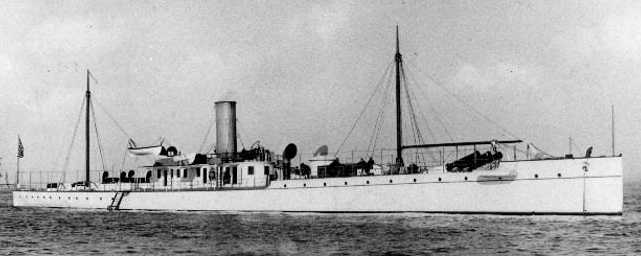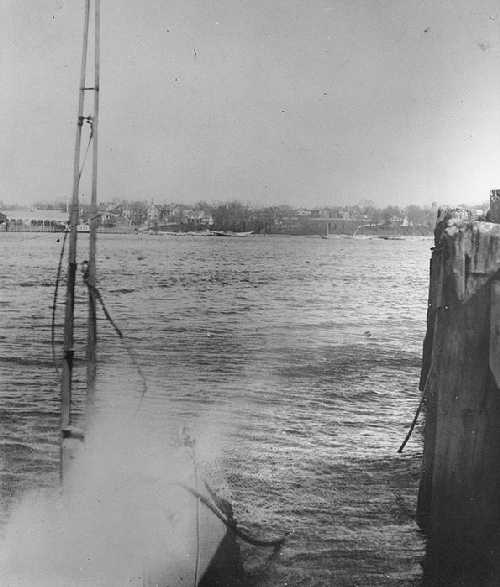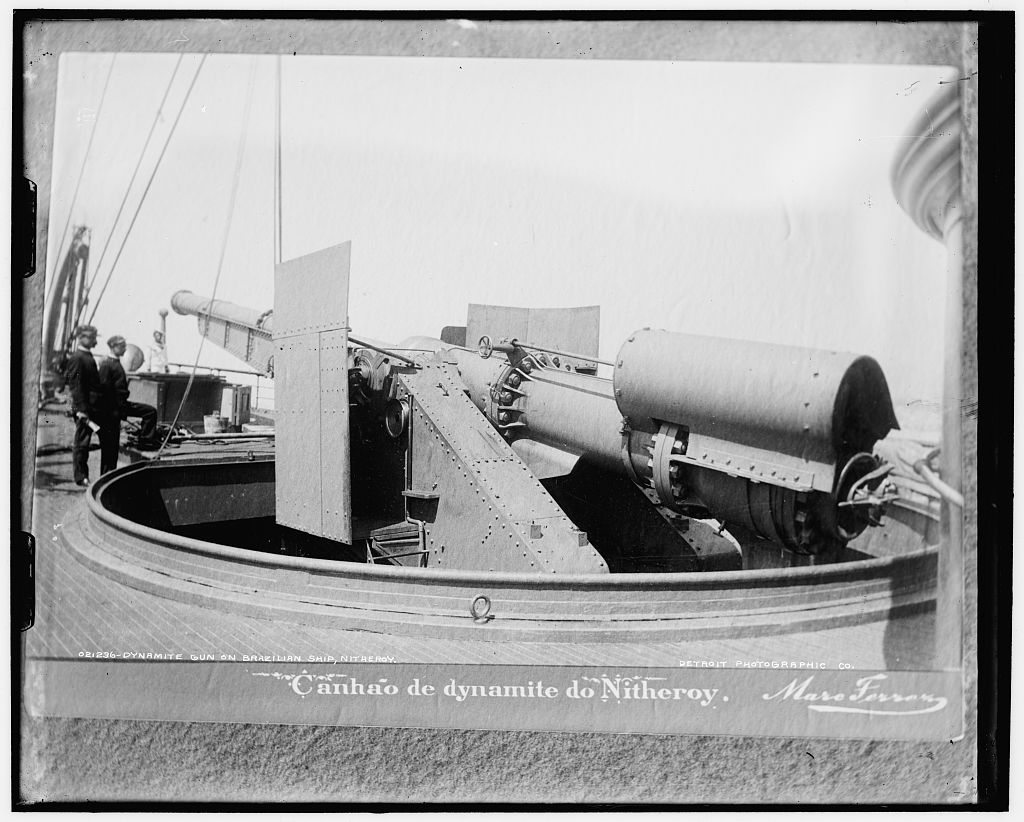
Developing a reliable HE projectile was a difficult task in the late 1800s. The explosives used as a burster, generally black powder or TNT, were susceptible to premature detonation due to the set-back shock experienced when the gun fired. In addition, fuzes were unreliable and duds were common.
An innovative proposal to reduce the firing shock by dispensing with the propellant entirely and instead use high pressure air was made by Captain Edmund Louis Gray Zalinsky (sometimes spelled as "Zalinski"), US Army. Captain Zalinsky was witness to an 1883 demonstration of a small air-gun model built by a Mr. Medford of Ohio and is credited with taking that idea and then developing and perfecting it into the "pneumatic dynamite torpedo gun." Captain Zalinsky served in the 5th U.S. Artillery Regiment from 1866 until his retirement for disability in February 1894, but continued to work on these weapons as a civilian following his retirement from the Army. Apparently in recognition for these services, the Army later promoted him to Major, although he did not return to commissioned service.
After a series of successful trials with small caliber prototypes, a three-gun battery of 15" (38.1 cm) pneumatic dynamite torpedo guns was installed at Sandy Hook, New Jersey, in 1894. The following year, a second three-gun battery was placed at Fort Winfield Scott, California. According to a report by the Army's Chief of Ordnance, by 1898 the Ordnance Department had "placed in serviceable condition the pneumatic-gun batteries at the ports of New York and San Francisco." This report also listed two additional batteries of pneumatic guns then in the process of being manufactured. Three years later, in 1901, the Ordnance Department reported the installation of these batteries at Fishers Island, New York, and at Hilton Head, South Carolina.
The US Navy also expressed interest in these guns and in June 1890 the well-known 930 ton (944 mt) Vesuvius "dynamite gun cruiser" was commissioned. Her armament consisted of three 15" (38.1 cm) pneumatic guns in a fixed installation firing forward with an outfit of ten shells per gun. Although modestly successful, these guns were found to have limited usefulness for naval service. As the installation could not be trained, the entire ship needed to be pointed at the target. Elevation was also fixed, but the range could be changed by adjusting the air pressure used. However, the maximum range of these guns was only about one and a half nautical miles, too short for even the limited battle ranges of the time.
Less well-known is that the US Navy's first practical submarine, Holland, had two 8.425" (21.4 cm) "dynamite torpedo guns" as commissioned, although one was later removed.
During the Spanish-American War, Vesuvius was employed off Cuba and performed eight shore bombardment missions against Santiago, Cuba, apparently all at night, with the first of these taking place on 13 June 1898. Her DANFS entry states: "Psychologically, Vesuvius' bombardment caused great anxiety among the Spanish forces ashore, for her devastating shells came in without warning, unaccompanied by the roar of gunfire usually associated with a bombardment." Realistically, the accuracy of such a fixed ship-board installation firing a few shells at a shore target in the darkness could not have been very good and any damage inflicted was almost certainly by chance rather than by design.
The Army projectiles were manufactured in four different sizes, one full-size and the others sub-caliber sized. These projectiles were all quite long when compared to conventional shells of the time, as they had boom-mounted tail fins. Although I have not been able to confirm this, the design of these shells leads me to believe that the gun was not rifled and that the stability of these projectiles in flight depended entirely upon these tail fins. The full-size, 15" (38.1 cm) projectile was eleven feet (3.35 m) long and weighed 1,150 lbs. (521.6 kg) when fully charged. The first sub-caliber projectile was 10" (25.4 cm) in diameter, eight feet (2.44 m) long and weighed 570 lbs. (259 kg) when fully charged. There were also 8" (20.3 cm) and 6" (15.2 cm) sub-caliber shells. The smaller shells allowed longer ranges to be obtained, but the longest range was still only about 5,000 yards (4,570 m).
The projectiles for the naval weapons used an electric cell to detonate the burster, which was a "desensitized blasting gelatin" composed of nitrocellulose and nitroglycerin. This was somewhat less sensitive to shock than regular dynamite.
During the Naval Revolt of 1893-1894, Brazil expressed an interest in this weapon and Captain Zalinsky installed a single 15 inch (38.1 cm) pneumatic gun aboard the converted Brazilian Nictheroy (ex-El Cid) in 1893. This weapon differed from those on Vesuvius by being installed in an electrically powered open mounting capable of being elevated and trained through an arc of 300 degrees. Crew for this weapon was one officer and 14 men. Quoting from the "Proceedings" article referenced below: "A correspondent on board that vessel writing under date of March 15, 1894 says Captain Baker and the other officers speak in enthusiastic terms of the trial of the cruiser's famous dynamite gun; just before entering the harbor on the day of the surrender of the rebel forces, a shell was fired at Pai Island in the bay and all agree that the explosion was 'fine'." It was probably fortunate that the mutineers surrendered, as the pnuematic gun was apparently disabled by this test shot. The gun's commander was suspected of being a traitor and was disrated as a result. Nictheroy was disarmed and the gun was then reportedly mounted as a coast defense weapon at Fort Sanata Cruz. Nictheroy was purchased by the USN in 1898 and was accepted into service as the auxiliary cruiser Buffalo.
Rapid developments in both propellants and projectiles during the late 1890s and early 1900s eliminated many of the problems that had led to these pneumatic guns and they were soon withdrawn from service. Vesuvius lost her pneumatic guns in 1904 and spent the rest of her career as a research torpedo boat. The Army guns followed, with those at the San Francisco battery being decommissioned in 1905.






Data from:
- "U.S. Battleships: An Illustrated Design History" and "U.S. Submarines through 1945: An Illustrated Design History" both by Norman Friedman
Other:
- "Battery Dynamite," at the "Gun Batteries of San Francisco" Website
- "Zalinski Pneumatic Dynamite Torpedo Gun, 1890s: A Working Bibliography" at the Ibiblio Website
- "Canon A Dynamite" article in 1886: premier semestre issue of "La Nature" Magazine, as shown on-line at Le Conservatoire numérique des Arts & Métiers Website
- Vesuvius DANFS entry at U.S. Naval Historical Center Website
Contemporary articles:
- "The U.S.S. Vesuvius: With Special Reference to Her Pneumatic Battery" article by Lt. Comdr. Seaton Schroeder, USN, in Proceedings of the United States Naval Institute, Vol. XX No. 1, 1894
- "Nictheroy has Sailed Away; Brazilian Cruiser Weighs Anchor for the West Indies" article in The New York Times of 22 November 1893
- "Nictheroy's Crew Paid Off; Will Leave Rio for New York on First Ship that Sails" article in The New York Times of 16 March 1894
- 06 April 2008
- Benchmark
- 21 April 2008
- Benchmark
- 01 April 2010
- Replaced picture of Coastal Artillery Gun
- 14 January 2011
- Added cutaway sketch
- 10 February 2015
- Corrected typographical error
